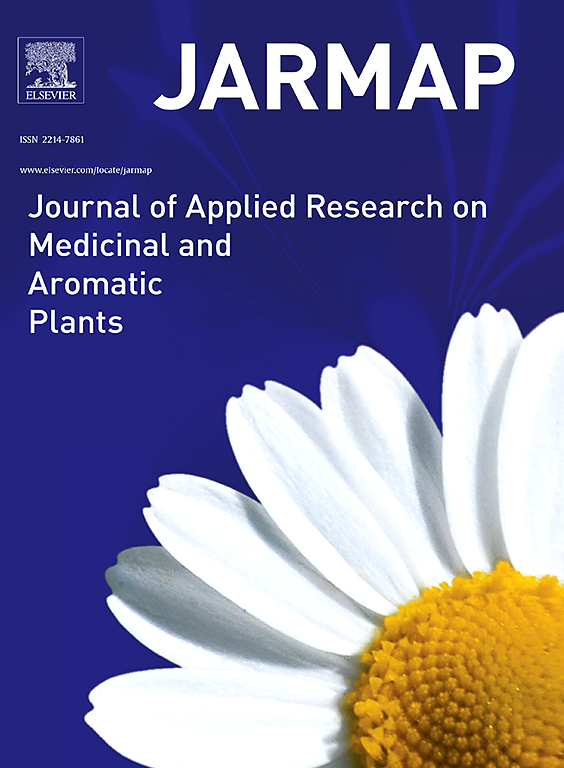Arthropods pest complex and associated natural enemies across different phenological growth stages of ashwagandha (Withania somnifera (L.) Dunal) in India: Insights for developing integrated pest management strategies for sustainable production
IF 3.6
2区 农林科学
Q1 PLANT SCIENCES
Journal of Applied Research on Medicinal and Aromatic Plants
Pub Date : 2024-10-10
DOI:10.1016/j.jarmap.2024.100590
引用次数: 0
Abstract
Withania somnifera (L.) Dunal, commonly known as ashwagandha, is one of the 55 species prioritized by the National Medicinal Plant Board, India. It is pharmacologically, an exceptional medicinal plant used in ayurvedic and indigenous medicinal systems. Damage by insect pests is a crucial obstruction for the industrially and commercially supreme medicinal plant, ashwagandha. Studies on a long-term basis to catalogue different arthropod pests damaging ashwagandha, their peak activity period, the vulnerability of the crop stage, natural enemies associated with recorded insect pests and their activity period were still unexplored. The current study was carried out for three consecutive years and recorded wholly 54 species of arthropods causing injury to the ashwagandha crop across different phenological crop growth stages, and 32 species of natural enemies managing these corresponding insect pests. Of the observed phytophagous arthropods, the Hemipteran species (61 %) were dominant, followed by Coleoptera (13 %), Lepidoptera (9 %), and Orthoptera (9 %). Here we explored the arthropod pest assemblage such as sap suckers (65 %), defoliators (33 %), and root feeders (2 %) infesting ashwagandha in the subtropical region of India. Amongst these pests, Henosepilachna vigintioctopunctata (Coleoptera: Coccinellidae) appeared as a major threat to the quality raw material production of ashwagandha. The full blossom with the initiation of berries was found to be a more vulnerable phenological stage, being attacked by 74 % of recorded arthropod pests. The natural enemies belonging to Coleoptera, Hemiptera, and Hymenoptera outnumbered the leftovers. This study also encapsulates the activity period of arthropod pests and their natural enemies, which can be a path road to choosing other integrable components in management strategy and also to articulate the conservation strategies. Since, information on arthropod pests and their natural enemies in the crop ecosystem is elementary to articulate any Integrated Pest Management (IPM) strategy and to the best of our knowledge, this is the first study conducted for a long period and making an inventory of arthropods infesting the ashwagandha crop, their correspondent natural enemies and their periods of activity can be a roadmap in constructing an IPM strategy for sustainable ashwagandha production.
印度灰树叶(Withania somnifera (L.) Dunal)不同物候生长阶段的节肢动物害虫群及相关天敌:为可持续生产制定虫害综合防治战略的启示
Withania somnifera (L.) Dunal,俗称灰树花,是印度国家药用植物委员会优先考虑的 55 个物种之一。从药理上讲,它是一种用于阿育吠陀和本土医药系统的特殊药用植物。虫害是灰树叶这种工业和商业价值极高的药用植物的主要障碍。对危害灰树叶的各种节肢动物害虫、其活动高峰期、作物生长阶段的脆弱性、与所记录害虫相关的天敌及其活动期的长期记录研究仍未进行。本次研究连续进行了三年,共记录了 54 种在不同物候期对白蜡树作物造成伤害的节肢动物,以及 32 种管理这些相应害虫的天敌。在观察到的植食性节肢动物中,半翅目物种(61%)占主导地位,其次是鞘翅目(13%)、鳞翅目(9%)和直翅目(9%)。在此,我们探讨了印度亚热带地区危害灰树叶的节肢动物害虫组合,如吸液虫(65 %)、落叶虫(33 %)和根食虫(2 %)。在这些害虫中,Henosepilachna vigintioctopunctata(鞘翅目:Coccinellidae)似乎是灰树叶优质原料生产的主要威胁。研究发现,开花和浆果成熟期是比较脆弱的物候期,74% 的记录在案的节肢害虫都会对其进行攻击。鞘翅目、半翅目和膜翅目的天敌数量超过了残留天敌。这项研究还概括了节肢动物害虫及其天敌的活动期,为选择管理策略中其他可整合的组成部分以及阐明保护策略提供了一条道路。由于作物生态系统中节肢害虫及其天敌的信息对于制定任何虫害综合防治(IPM)战略都是至关重要的,据我们所知,这是首次进行长期研究,对侵扰灰树叶作物的节肢动物、相应的天敌及其活动期进行清点,可以为制定灰树叶可持续生产的 IPM 战略提供路线图。
本文章由计算机程序翻译,如有差异,请以英文原文为准。
求助全文
约1分钟内获得全文
求助全文
来源期刊

Journal of Applied Research on Medicinal and Aromatic Plants
Pharmacology, Toxicology and Pharmaceutics-Drug Discovery
CiteScore
6.40
自引率
7.70%
发文量
80
审稿时长
41 days
期刊介绍:
JARMAP is a peer reviewed and multidisciplinary communication platform, covering all aspects of the raw material supply chain of medicinal and aromatic plants. JARMAP aims to improve production of tailor made commodities by addressing the various requirements of manufacturers of herbal medicines, herbal teas, seasoning herbs, food and feed supplements and cosmetics. JARMAP covers research on genetic resources, breeding, wild-collection, domestication, propagation, cultivation, phytopathology and plant protection, mechanization, conservation, processing, quality assurance, analytics and economics. JARMAP publishes reviews, original research articles and short communications related to research.
 求助内容:
求助内容: 应助结果提醒方式:
应助结果提醒方式:


